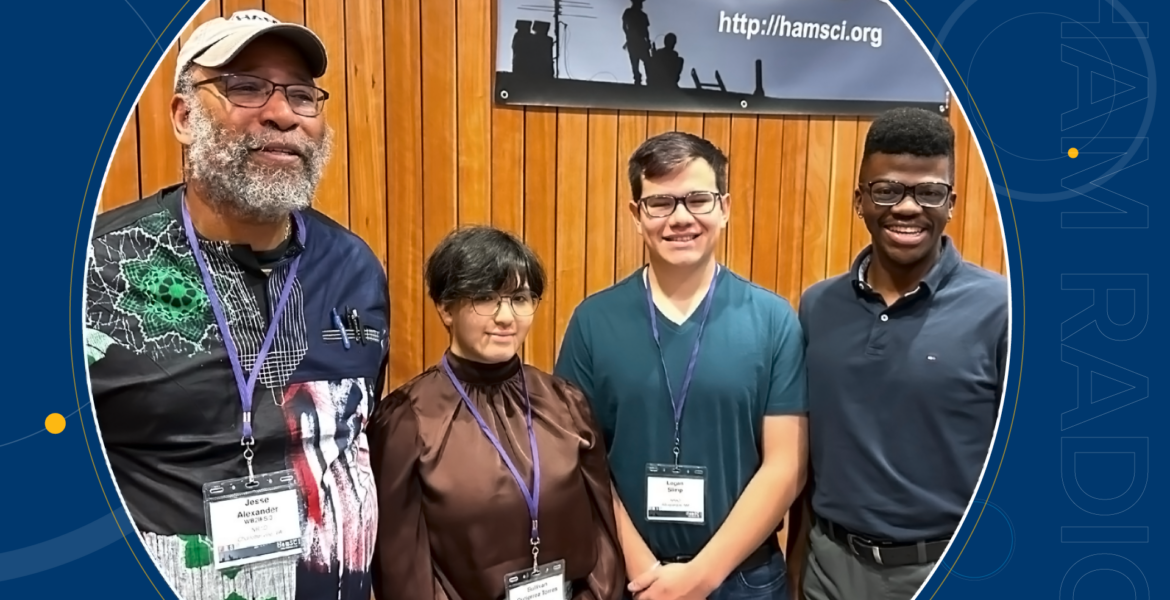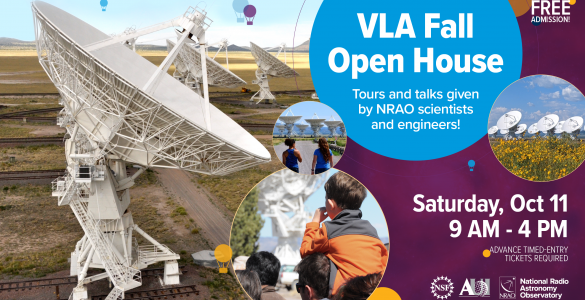Following a grant from Amateur Radio Digital Communications (ARDC), the National Science Foundation‘s (NSF’s) National Radio Astronomy Observatory (NRAO) launched a two-year project to engage BIPOC and LGBTQIA+ learners in learning about the electromagnetic spectrum and discovering the excitement of ham radio. The project, Exploring the Electromagnetic Spectrum (EMS) with Amateur Radio, offered its first learner-facing training in January 2023.
The Ham Radio and the EMS project goal is to introduce learners to the EMS and radio technologies by developing a scalable, shareable curriculum on NRAO’s broader impacts-focused SuperKnova learning platform. The curriculum provides hands-on activities to deepen subject knowledge and strengthen learners’ STEM identity while supporting the attainment of Technician and General Class Amateur Radio Licenses. Additionally, cohort-building exercises and networking with various NRAO staff were prioritized to build comfort, trust, and confidence within the cohort.
The Wave 1 cohort completed the 20-week Technician’s license course, and five learners successfully passed the Technician’s Class license exam. Three of these newly licensed amateurs are continuing in the summer General upgrade class. General Class licenses will provide these learners with greater privileges and access to the amateur radio portions of the EMS.
Support for this first cohort continues in numerous ways, including reimbursements for membership to local clubs and the American Radio Relay League (ARRL); networking on “Harriet’s Observatory”, a virtual amateur radio club on Discord; virtual office hours with instructors upon request; and hand-on activities related to amateur radio and the use of the EMS.
Planning for the Wave 2 cohort is in progress, and it will use feedback from the first cohort of learners to improve the program. The Ham Radio and the EMS project has just finished recruitment, made offers to learners, and learners have accepted. The Wave 2 cohort will have 18 learners from across the US. Early support and engagement with amateur radio can create pathways for learners toward future STEM careers and introduce them to a lifelong, rewarding hobby.
The $315,123 ARDC grant includes support for developing curricula that will be freely available to school groups, community clubs, and educational institutions. This curriculum is set to be available next year.
To learn more about the EMS/Ham Radio Project, please visit https://superknova.org/ham-radio-project/.
About NRAO
The National Radio Astronomy Observatory (NRAO) is a facility of the National Science Foundation (NSF), operated under cooperative agreement by Associated Universities, Inc. Furthering NSF’s mission to advance the progress of science, the NRAO enables research into the Universe at radio wavelengths and provides world-class telescopes, instrumentation, and expertise to the scientific community. NRAO’s mission includes a commitment to broader, equitable, inclusive participation in science and engineering, training the next generation of scientists and engineers, and promoting astronomy to foster a more scientifically literate society. NRAO operates three research facilities: the Atacama Large Millimeter/submillimeter Array (ALMA), the Karl G. Jansky Very Large Array (VLA), and the Very Long Baseline Array (VLBA), which are available for use by scientists from around the globe, regardless of institutional or national affiliation. NRAO welcomes applicants who bring diverse and innovative dimensions to the Observatory and to the field of radio astronomy. For more information about NRAO, go to https://public.nrao.edu.
About ARDC
Amateur Radio Digital Communications (ARDC) is a California-based foundation with roots in amateur radio and the technology of internet communication. The organization got its start by managing the AMPRNet address space, which is reserved for licensed amateur radio operators worldwide. Additionally, ARDC makes grants to projects and organizations that follow amateur radio’s practice and tradition of technical experimentation in both amateur radio and digital communication science. Such experimentation has led to advances that benefit the general public, including the development of the mobile phone and wireless internet technology. ARDC envisions a world where all such technology is available through open source hardware and software, and where anyone has the ability to innovate upon it. To learn more about ARDC, please visit https://www.ardc.net/.
Media Contact:
Jill Malusky
Public Information & News Manager, NRAO
304-460-5608
jmalusky@nrao.edu
Rebecca Key, KO4KVG
ARDC Communications Manager
858-477-9903
rebecca@ardc.net











